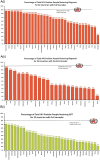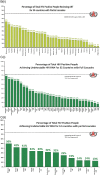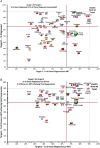Can the UNAIDS 90-90-90 target be achieved? A systematic analysis of national HIV treatment cascades
- PMID: 28588933
- PMCID: PMC5321333
- DOI: 10.1136/bmjgh-2015-000010
Can the UNAIDS 90-90-90 target be achieved? A systematic analysis of national HIV treatment cascades
Abstract
Background: In 2014, the Joint United Nations Programme on HIV and AIDS (UNAIDS) and partners set the '90-90-90 targets'; aiming to diagnose 90% of all HIV positive people, provide antiretroviral therapy (ART) for 90% of those diagnosed and achieve viral suppression for 90% of those treated, by 2020. This results in 81% of all HIV positive people on treatment and 73% of all HIV positive people achieving viral suppression. We aimed to analyse how effective national HIV treatment programmes are at meeting these targets, using HIV care continuums or cascades.
Methods: We searched for HIV treatment cascades for 196 countries in published papers, conference presentations, UNAIDS databases and national reports. Cascades were constructed using reliable, generalisable, recent data from national, cross-sectional and longitudinal study cohorts. Data were collected for four stages; total HIV positive people, diagnosed, on treatment and virally suppressed. The cascades were categorised as complete (four stages) or partial (3 stages), and analysed for 'break points' defined as a drop >10% in coverage between consecutive 90-90-90 targets.
Results: 69 country cascades were analysed (32 complete, 37 partial). Diagnosis (target one-90%) ranged from 87% (the Netherlands) to 11% (Yemen). Treatment coverage (target two-81% on ART) ranged from 71% (Switzerland) to 3% (Afghanistan). Viral suppression (target three-73% virally suppressed) was between 68% (Switzerland) and 7% (China).
Conclusions: No country analysed met the 90-90-90 targets. Diagnosis was the greatest break point globally, but the most frequent key break point for individual countries was providing ART to those diagnosed. Large disparities were identified between countries. Without commitment to standardised reporting methodologies, international comparisons are complex.
Conflict of interest statement
Competing interests: None declared.
Figures




References
-
- The Joint United Nations Programme on HIV/AIDS. 90–90-90 An ambitious treatment target to help end the AIDS epidemic. 2014;JC2684. http://www.unaids.org/sites/default/files/media_asset/90-90-90_en_0.pdf
LinkOut - more resources
Full Text Sources
Other Literature Sources
Miscellaneous
